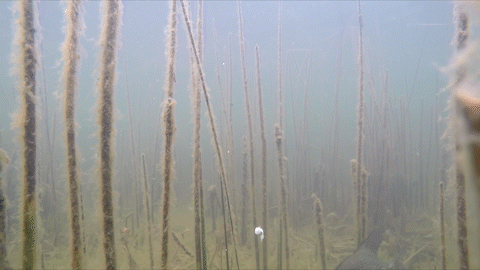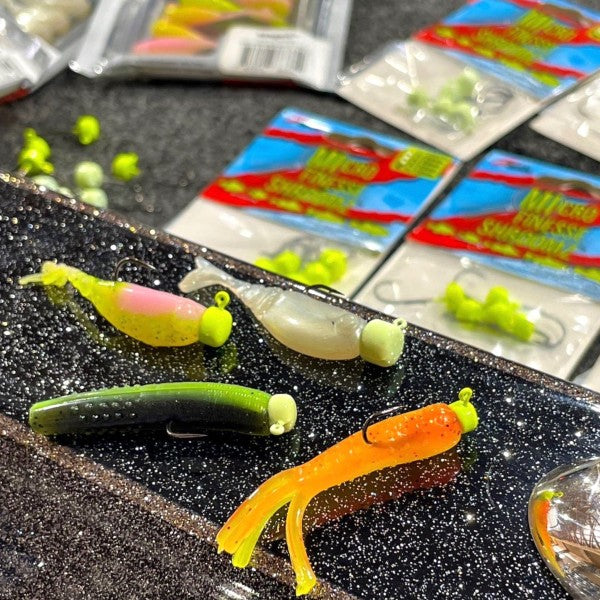
Superplastics for Spring Panfish


Superplastics for Spring Panfish
New high performance softbaits coax crappies, bluegills & perch in abundance
Even among the nation's best bass anglers, whispers of words like big crappies attract a captive audience. So it was for Major League Fishing star David Walker, a confirmed crappie sneak. One day, while driving home from his latest bass derby, Walker found himself daydreaming about a local crappie lake and the makings of an epic fish fry. "After a hectic bass tourney, I love coming home and catching a boatload of crappies or white bass with my daughters," says Walker, a wizard with a small jig and softbait.
A lifelong panfish fan, Walker recently discovered a new bait concept for crappies, perch and bluegills. Ironically, the idea first occurred to him while fishing bass tournaments.
About Superplastics
"When I first started throwing these so called 'superplastics' for bass several years ago, I quickly learned an almost magical advantage of the material known as ElaZtech, which was that panfish and other nuisance fish couldn't peck the tails off the back of your bass jigs," recalls Walker. "While bass fishing with traditional soft plastics, it's always been a headache and major time waster when you've got perch, sunfish and other tail-pecking fish in the area. But using these ElaZtech baits, I discovered panfish could peck them all they wanted, with little to no effect on the bait. I could stay in the game, non-stop, without reeling torn baits back to the boat, and constantly re-rigging a new tail."'\

Micro Finesse superplastics exhibit remarkable fish-catching advantages.
All the while, Walker was thinking about crappies. He knew that ElaZtech's advantages held tremendous panfish potential. "This is a material that's wonderfully soft and lively, making it easy to activate, so it moves and undulates fluidly in the water," he notes.
"Like most anglers, I accepted for years that traditional panfish sized soft plastics just don't move that well underwater. Because they're relatively rigid, traditional soft crappie baits tend to lose action the smaller you make them. So, you often had to resort to larger baits than you wanted or had to retrieve them faster to achieve the desired tail movement or the right swimming action. Neither are ideal for a fish that often exhibits size and speed selectivity in their feeding habits.
"You'll understand that when I started fishing ElaZtech, I was pretty excited about its advantages for bass. But secretly, I couldn't wait until panfish-sized superplastics arrived on the scene. Combine a super soft, lively bait with crazy durability and you quickly appreciate what I'm saying. This stuff has all the makings of the perfect panfish bait."

MLF bass pro David Walker with a superplastics crappie.
Rate-of-Fall Swimbaits
A few days after the finish of a recent bass tournament, Walker found himself on his favorite crappie lake. He spotted the aqua-blue packs of new Z-Man Micro Finesse baits lying on his boat deck and a light bulb ignited. "I grabbed up a pack of Shad FryZ™— a cool little 1-3/4-inch paddletail swimbait— and put it on a 1/10-ounce Micro Finesse ShroomZ™ panfish jig. Almost immediately, it became my favorite crappie bait, and here's why."
From the first few casts, Walker noticed that in water the bait's tail activated and kicked realistically, almost effortlessly, even at slow retrieve speeds. "The Shad FryZ is one of those rare crappie-sized swimbaits whose tail will wag and thump even as it's falling. Crappies can be really speed sensitive, in terms of lure retrieves and drop-speed. Too many traditional crappie baits require excessive speed to activate them; often, that's too fast for crappies, especially in cooler water."
Walker, a deep-thinking angler who's always conjuring ways to maximize lure performance, suggests that bait buoyancy and rate-of-fall remain two ignored factors in the crappie-catching equation. "Consider that the natural buoyancy of the Shad FryZ slows its sink rate. So, while I can benefit from the extra casting weight of a 1/10-ounce jig, the rigged bait flutters and fishes more like a 1/16-ouncer. And it still exhibits that nice natural tail-kick on the fall that induces bites.
"As veteran anglers know, crappies primarily feed up," Walker continues. "So, keeping your lure at or a few feet above their eye level is of utmost importance, especially in spring."
Unlike traditional PVC soft plastics, which sink, Walker notes that ElaZtech baits float, slowing the drop-speed of the jighead. "That's something you simply can't do with other crappie baits, because traditional plastisol baits sink fast—often, shooting right through the active strike zones of crappies and other panfish."

Superplastics Hacks
To further tweak rate of fall, Walker spools with "straight 6- or 8-pound test braided line and no leader," he suggests. "After trying those micro-thin 2-, 3- and 4-pound test braids, I realized thicker diameter braid, which floats, slows the lure's rate of fall a bit more."
Walker offers another tip for creating a semi-permanent soft "lure" that catches dozens of fish without replacing the tail. "Add one drop of Loctite Gel Control glue to the jighead before threading on the Shad FryZ or other Micro Finesse body," he explains. "This locks the bait in place and has allowed me to catch close to 50 crappies on one single bait—all without re-rigging or even re-positioning the original bait on the jig hook."
Analogous to the way anglers initially perceived braided superlines, Walker acknowledges that anglers often approach superplastics with hesitation. "Similar to superlines, which require different knots, ElaZtech baits call for slightly different rigging and storage," he notes. "But the advantages are too dramatic to ignore.
"To rig a bait onto a jighead, thread the body onto the hook in traditional fashion. Then, rather than pushing it up and over the jig's keeper barbs, grasp the bait by the head and pull and stretch it right up tight to the jighead. This material is so stretchy and resilient that you almost can't rip it by hand.
"For storage, just keep baits in their original packs— don't mix them with regular soft plastics in storage compartments—and your superplastics will last for years. That's all there is to it."

